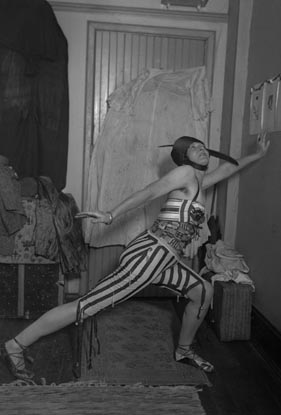Unhampered by Sanity: Poetry History Shall Have Baroness Elsa

In a new, comprehensive feature on Jacket2, they're looking at the most famous woman in Dada, polymorphous artist Baroness Elsa von Freytag-Loringhoven. The Baroness has been the focus of much cultural study over the last decade, but has dropped out the bottom of the American poetry narrative. And so: "We locate and situate her poetry in previous and current literary trends by introducing three previously unpublished poems, new and groundbreaking biographical facts concerning the Baroness’s German poetry, a rereading of her Dadaist poetry that situates it within the frame of feminist performance art, and a contemporary poetic response to her work."
The loss of the Baroness from the world of letters might have been due to bad feelings about Dada:
In particular, readers contested the value of Dada poetry and “the Baroness” became coterminous with what some considered the worst of this experimental movement. In January 1922, for example, Harriet Monroe wrote in Poetry that “the Little Review […] is headed straight for Dada; but we could forgive even that if it would drop Else von Freytag-Loringhoven on the way.”[1]Jane Heap, editor of The Little Review, responded in a brief piece entitled “Dada” that “[w]e do intend to drop the baroness — right into the middle of the history of American poetry,” for the very reason that “the Baroness,” whom Heap calls “the first American dada,” represents lived art: she is “the only one living anywhere who dresses dada, loves dada, lives dada.
The three poems published here, "Astride," "Aphrodite to Mars," and "Hell's Wisdom" are done so for the first time, having been rescued from the Baroness's archives at the University of Maryland. Editor Julia Bloch has also pointed us to the original manuscripts of the poems, which have been transcribed for us to read here; and certainly there's a visible excitement present in the handwriting of the originals that should be viewed, so kudos for the inclusion.
Before going into details of the actual poems, Tanya Clement's essay touches on why a magazine like The Little Review would have pushed for Baroness Elsa's work in the first place. Interestingly, it's to do with James Joyce:
By including provocative pieces by the Baroness, the editors of The Little Review, Margaret Anderson and Jane Heap, placed their little magazine in the center of literary debate. “Holy Skirts,” which discusses sexuality in terms of the Catholic church, was printed in the July–August 1920 issue and represents a poem with an increasingly irreverent sense of play and obvious criticism for more traditional cultural institutions.[5] It is also a poem that alludes to the most talked-about literary court case in history since the same issue also contains a section from the “Nausicaa” episode of Ulysses in which Leopold Bloom has an orgasm while looking up a young woman’s skirt as she leans back to look at a fireworks display. This was the last section of Ulysses to be printed by The Little Review before Heap and Anderson were taken to court and sued over the excerpts. Specifically, the presences of this irreverent poem as well as a photograph of a seminude Baroness on the frontispiece of the same issue in which Heap’s article “Art and the Law”[6] appeared, helped foreground the editors’ belief that the Ulysses censorship trial was about “women’s issues” and “claiming sexual pleasure and agency for American women.”[7] In thinking back on to why she started The Little Review, Margaret Anderson sees dialogue as central: “It was the moment. The epoch needed it. The thing I wanted — would die without — was conversation.”[8] “King Adam” (May 1919) and “Holy Skirts” (July–August 1920) ask general, provocative questions about the role — the value — of women and sex in modernist society, but their presence also creates a space in the magazine in which Heap and Anderson could employ the Baroness’s poetry and presence to encourage, enact, and comment on the controversy surrounding excerpts of James Joyce’s Ulysses published in The Little Reviewin the 1920s.
Another enlightening moment:
Tension within the 1920s literary community around the value of Dada art is never more apparent than in the discourse that followed the 1919 publication of the Baroness’s poem “Mineself——Minesoul——and——Mine——Cast-Iron Lover.”[10] The discussion ensued in The Little Review in December 1919 and January 1920 under the title “The Art of Madness” and included Heap, Maxwell Bodenheim, Evelyn Scott, and the Baroness, among others. It was sparked by Heap’s response in “The Reader Critic” — the section of the magazine reserved for reader comments — to readers who thought “Cast-Iron Lover” was written by someone who was in “a condition of disease and mania”.[11] In response, Heap argues that the Baroness is merely “unhampered by sanity” and able to “work” insanity “to produce Art.” Heap calls her work “the Art of Madness,” asserting: “It wouldn’t be the art of madness if it were merely an insanity”: in fact, Heap writes, “Madness is her chosen state of consciousness.”
The feature also includes pieces by Kimberly Lamm, Gaby Divay, and Joseph Donahue. Well worth a look.


